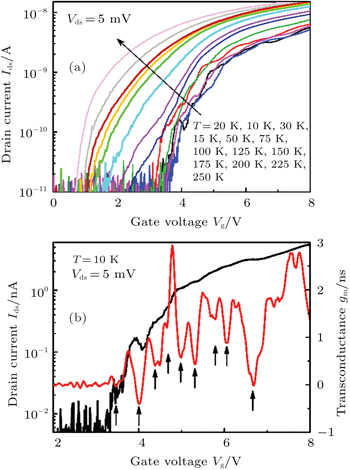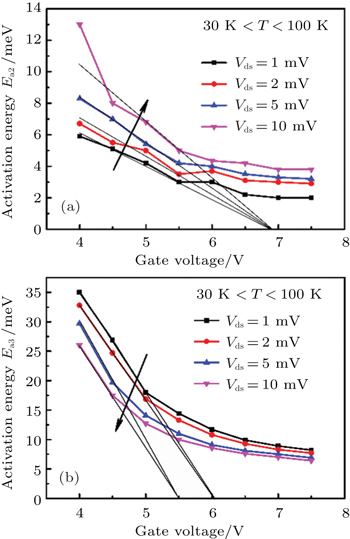† Corresponding author. E-mail:
‡ Corresponding author. E-mail:
Project supported partly by the National Key R & D Program of China (Grant No. 2016YFA02005003) and the National Natural Science Foundation of China (Grant Nos. 61376096 and 61327813).
We study electric-field-dependent charge delocalization from dopant atoms in a silicon junctionless nanowire transistor by low-temperature electron transport measurement. The Arrhenius plot of the temperature-dependent conductance demonstrates the transport behaviors of variable-range hopping (below 30 K) and nearest-neighbor hopping (above 30 K). The activation energy for the charge delocalization gradually decreases due to the confinement potential of the conduction channel decreasing from the threshold voltage to the flatband voltage. With the increase of the source–drain bias, the activation energy increases in a temperature range from 30 K to 100 K at a fixed gate voltage, but decreases above the temperature of 100 K.
The conventional metal-oxide-semiconductor field effect transistor (MOSFET) has entered the sub-20-nm stage and encountered more and more physical and technology limitations.[1,2] The artificial quantum dot made in MOSFET could exhibit quantum transport at room temperature.[3] When the effective gate length of silicon MOSFET is of the order of dozens of nanometers, the electrical properties of the device are no longer dependent on the average doping density but the distribution of individual dopant atoms in the channel. The random distribution of dopant atoms in the silicon nanowire, which act as quantum dots (QDs), will affect the electrical characteristics.[4–7] The scanning tunneling microscope (STM) with atomic resolution has been used to fabricate single dopant atom devices on a silicon surface terminated with hydrogens.[8] Further, the transport spectroscopy of a single dopant atom in an n–p–n silicon nanowire transistor has been investigated in recent years.[9,10] Compared with those in the inversion-mode transistor, carriers in the silicon junctionless nanowire transistor (JNT) flow in the middle of the nanowire instead of the surface inversion layer, which leads to more apparent quantum-confinement effect on the carrier transport.[11–15] At the initial stage of conduction, the carriers flow through a very narrow conductive path in the center of the nanowire. With the gate voltage increasing, the conductive path is gradually broadened until it forms a cross-section physically.[11] The electric field perpendicular to the current flow is lower in JNT than in a regular inversion-mode transistor. The electrons in JNT mainly flow through a bulk channel instead of a surface channel. Thus it can be seen that the surface roughness scattering has little influence on electron mobility. The more significant current oscillations could be observed in JNTs.[13] Therefore, it is very necessary to understand the influence of dopant atoms on the carrier transport behaviors in the variable conductive path of JNT.
In this work, we fabricate an n-type single-channel silicon JNT and experimentally investigate the electric-field-dependent charge delocalization from dopant atoms in a temperature range from 10 K to 250 K. Previously, Prati et al. observed the Anderson–Mott transition from the individual donor regime to the Hubbard band regime in silicon transistor doped with a few arsenic atoms.[16] More recently, Qiu et al. demonstrated the transport of few-layer molybdenum disulphide (MoS2) in low-carrier-density regime, which can be explained by hopping through defect-induced localized states.[17] Turk et al. investigated the gate dependence of charge delocalization below the mobility edge in a QD field effect transistor at low temperatures.[18] Roche et al. measured a large valley-orbit splitting for shallow isolated phosphorus donors in a silicon gated nanowire by using a double dopant transport spectroscopy.[19] Here we present the Arrhenius plot of the temperature-dependent conductance, which demonstrates that the electron transport behavior changes from variable-range hopping to nearest-neighbor hopping, at a transition temperature of 30 K. The activation energy for the charge delocalization, extracted from the Arrhenius plot, gradually decreases due to the confinement potential of the conduction channel decreasing from the threshold voltage to the flatband voltage. Furthermore, we find that the activation energy at the fixed gate voltage increases with increasing source–drain bias within a temperature range from 30 K to 100 K, but decreases above the temperature of 100 K.
The schematic structure of JNT investigated in this work is shown in Fig.
 | Fig. 1. Schematic three-dimensional layout of the device and top-view SEM images of silicon nanowire. |
The inset of Fig.
Figure
 | Fig. 2. (a) Ids–Vg of the JNT in a temperature range from 10 K to 250 K at Vds = 5 mV. (b) Drain current curve and corresponding transconductance curve with Vds = 5 mV at 10 K. |
Figure
To obtain a better insight into the transport behaviors through the donor-induced QDs, the Arrhenius plot of the temperature-dependent conductance is shown in Fig.
 | Fig. 3. (a) Arrhenius plots of the conductance at Vds = 5 mV for various gate voltages. (b) Plots of the activation energy versus gate voltages in different temperature regions. |
In the lower temperature region (T < 30 K), the conductance is very weakly temperature-dependent due to the hopping electrons with the activation energy Ea1 less than 0.3 meV. Coulomb blockade and sequential tunneling through the donor-induced QDs are dominant. The activation energy Ea1 is independent of gate voltages only because the electron transport is dominated by varying-range electrons hopping with extremely low activation energy from one dopant atom to another. The density of the localized sites is very small as a Wigner-like system within the energy band so that the hopping electrons will not find the nearest neighbors but for those at the shortest hopping distance. Previously, we found that there exists an energy balance between the thermal activation and the Coulomb interaction at a critical temperature.[17] The transition temperature Tc has been derived from the balance condition to be Tc = 2.4e4ag0/kB(4πεrε0)2, where a is the localization length, g0 is the density of states at the Fermi energy, kB is the Boltzmann constant. The localization length a is estimated by using the QD radius of 0.99 nm. According to the implantation dose, the doping concentration ND is estimated to be 3 × 1018 cm−3. The mean distance between phosphorus donors is estimated to be 
Above the critical temperature of transition from the melting of the Wigner-like system into the Fermi glass, thermally activated hopping transport is observed clearly with the increase of the drain current intensity in Fig.
In addition, with the increase of temperatures, it is easy to observe in Fig.
 | Fig. 4. Derivative of the transconductance (dgm/dVg) as a function of gate voltage at Vds = 5 mV and T = 150 K. The inset shows the flatband voltages at different drain voltages and temperatures. |
The first peak is corresponding to the threshold voltage. Following the first peak in the dgm/dVg curve, the flat region is considered here as the flatband voltage because the gate control ability remains stable. The inset in Fig.
In addition to the influence of transverse electric field from gate voltage, the longitudinal electric field also has an effect on the transport behavior. The longitudinal electric field from the source–drain bias is along the silicon nanowire channel. Figures
 | Fig. 5. Plots of activation energies (a) Ea2 and (b) Ea3 versus gate voltage for different source–drain bias voltages. |
Figure
 | Fig. 6. Schematic conduction band diagram for an n-channel JNT in longitudinal direction at Vds = 0 and Vds > 0. |
The gate-induced barrier height decreases with the increases of gate voltage and source–drain bias voltage, which can be reflected in Fig.
In this work, we directly prove the electric-field-dependent charge delocalization from dopant atoms in silicon JNT by the Arrhenius plot of the temperature-dependent conductance. The temperature-dependent activation energies at different gate voltages and source–drain bias voltages have profound implications for the electron transport behaviors, changing from variable-range hopping to nearest-neighbor hopping. This result offers an encouraging prospect for developing the complex logic structures by using electric-field-dependent donor states, which pave the way for new applications in quantum electronics.
| 1 | |
| 2 | |
| 3 | |
| 4 | |
| 5 | |
| 6 | |
| 7 | |
| 8 | |
| 9 | |
| 10 | |
| 11 | |
| 12 | |
| 13 | |
| 14 | |
| 15 | |
| 16 | |
| 17 | |
| 18 | |
| 19 | |
| 20 | |
| 21 | |
| 22 | |
| 23 | |
| 24 | |
| 25 | |
| 26 | |
| 27 | |
| 28 |


